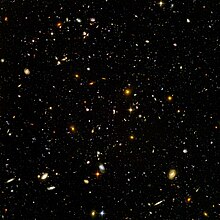
Back Sterrestelsel Afrikaans Galaxie ALS ረጨት Amharic Galaxia AN मंदाकिनी ANP مجرة Arabic مجرة ARY مجره ARZ তাৰকাৰাজ্য Assamese Galaxa AST

Eine Galaxie ist eine durch Gravitation gebundene große Ansammlung von Sternen, Planetensystemen, Gasnebeln, Staubwolken, Dunkler Materie und sonstigen astronomischen Objekten mit einer Gesamtmasse von typischerweise 109 bis 1013 Sonnenmassen (M☉). Ihr Durchmesser kann mehrere hunderttausend Lichtjahre betragen.[1] Während große Galaxien häufig die Struktur von Spiralen ausbilden, sind Zwerggalaxien zumeist irregulären Typs. Daneben existieren weitere Arten und Formen. Die Milchstraße, Heimatgalaxie unseres Sonnensystems, ist eine Balkenspirale von rund 1,5 Billionen M☉ mit etwa 250 Milliarden Sternen. Von der Erde aus lassen sich mit aktueller Technik mehr als 50 Milliarden Galaxien beobachten.[1] Seit 2016 geht die Forschung davon aus, dass sich im beobachtbaren Universum ca. eine Billion Galaxien befinden.[2][3]

Galaxien variieren stark in Aussehen (Morphologie), Größe und Zusammensetzung. Die Milchstraße hat einen Durchmesser von bis zu 200.000 Lichtjahren[4] und gehört damit zu den größeren Galaxien. Ihre nächste Nachbargalaxie von vergleichbarer Größe ist die Andromedagalaxie in einer Entfernung von rund 2,5 Millionen Lichtjahren.[5][6][7][8] Das entspricht etwa dem mittleren Abstand zwischen allen Galaxien von rund drei Millionen Lichtjahren.[9] Zusammen mit weiteren Galaxien von geringerer Masse bilden beide Galaxien die Lokale Gruppe. Galaxien treten oft in solchen Gruppen oder Haufen mit bis zu einigen tausend Mitgliedern auf.
- ↑ a b Adalbert W. A. Pauldrach: Das Dunkle Universum. Der Wettstreit Dunkler Materie und Dunkler Energie: Ist das Universum zum Sterben geboren? Springer Spektrum, 2. Aufl. 2017 S. 546, ISBN 978-3-662-52915-7.
- ↑ Galaxien in Hülle und Fülle. In: FAZ.net. 14. Oktober 2016, abgerufen am 1. April 2020.
- ↑ Christopher J. Conselice, Aaron Wilkinson, Kenneth Duncan, Alice Mortlock: The Evolution of Galaxy Number Density at z < 8 and its Implications. In: The Astrophysical Journal. Band 830, Nr. 2, 13. Oktober 2016, ISSN 1538-4357, S. 83, doi:10.3847/0004-637X/830/2/83, arxiv:1607.03909 [abs].
- ↑ M. López-Corredoira, C. Allende Prieto, F. Garzón, H. Wang, C. Liu: Disk stars in the Milky Way detected beyond 25 kpc from its center. In: Astronomy & Astrophysics. Band 612, April 2018, ISSN 0004-6361, S. L8, doi:10.1051/0004-6361/201832880 (aanda.org [abgerufen am 13. Juni 2018]).
- ↑ K. Z. Stanek, P. M. Garnavich: Distance to M31 with the Hubble Space Telescope and Hipparcos Red Clump Stars. In: Astrophysical Journal. Band 503, Nr. 2, 1998, S. L131-L134, bibcode:1998ApJ...503L.131S.
- ↑ Ignasi Ribas, Carme Jordi, Francesc Vilardell, Edward L. Fitzpatrick, Ron W. Hilditch, Edward F. Guinan: First Determination of the Distance and Fundamental Properties of an Eclipsing Binary in the Andromeda Galaxy. In: Astrophysical Journal. Band 635, Nr. 1, Dezember 2005, S. L37-L40., doi:10.1086/499161, arxiv:astro-ph/0511045, bibcode:2005ApJ...635L..37R.
- ↑ R. Wagner-Kaiser, A. Sarajedini, J. J. Dalcanton, B. F. Williams, A. Dolphin: Panchromatic Hubble Andromeda Treasury XIII: The Cepheid period-luminosity relation in M31. In: Mon. Not. R. Astron. Soc. Band 451, 2015, S. 724–738, bibcode:2015MNRAS.451..724W.
- ↑ A. R. Conn, R. A. Ibata, G. F. Lewis, Q. A. Parker, D. B. Zucker, N. F. Martin, A. W. McConnachie, M. J. Irwin, N. Tanvir, M. A. Fardal, A. M. N. Ferguson, S. C. Chapman, D. Valls-Gabaud: A Bayesian Approach to Locating the Red Giant Branch Tip Magnitude. II. Distances to the Satellites of M31. In: Astrophysical Journal. Band 758, Nr. 1, 2012, S. 11.1–11.19, bibcode:2012ApJ...758...11C.
- ↑ Eckhard Rebhan: Theoretische Physik: Relativitätstheorie und Kosmologie. Spektrum Akademischer Verlag, Heidelberg 2012, ISBN 978-3-8274-2315-3, S. 379.
Theo Mayer-Kuckuk: Kernphysik. Eine Einführung. Vieweg+Teubner, Wiesbaden 2013, ISBN 978-3-322-84876-5, S. 290.